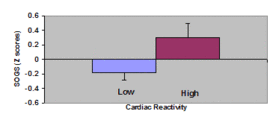The Wager, 8(14) – Reward and Risk: Identifying a Physiological Marker for PG
Researchers who demonstrated that individuals with alcohol dependence are more likely to experience a leap in their baseline heart rate (HR) following alcohol consumption (Conrod, Peterson, Pihl, & Mankowski, 1997; Wilson & Nagoshi, 1988) suggested that the leap indicates a genetically programmed sensitivity to reward (Conrod, Peterson, & Pihl, 2001). Because alcohol dependence and pathological gambling are frequently comorbid (see for example WAGER 8(13)), Brunelle et al. (2003) hypothesized that individuals who showed cardiac reactivity to alcohol would be at greater risk for gambling pathologically. This week’s WAGER reviews their work on ethanol-induced cardiac reactivity and gambling.
Researchers recruited participants from a cohort of 1,037 French-speaking Caucasian males from Montreal who are part of an ongoing longitudinal study begun when the participants were five years old. Researchers screened one-third of the cohort and excluded 151 individuals: exclusion criteria included, but were not limited to, the presence of medical problems, substance dependence, and inexperience with the amount of alcohol used in the study. Of those who screened in, 105 agreed to participate. Researchers measured baseline HR before and after the participants imbibed 3 alcoholic drinks over a fifteen minute period. The difference between the sober HR and intoxicated HR was the measure of cardiac reactivity to ethanol. On a separate day, participants completed the South Oaks Gambling Screen over the phone (Lesieur & Blume, 1987).
As Figure 1 illustrates, participants who displayed high cardiac reactivity to ethanol (n=53) had significantly higher Z-transformed scores on the SOGS compared to those who displayed low cardiac reactivity (n=52) (F(1,103) = 5.33, p =.02).
Figure 1. Mean group differences (+SE) between groups with low and high cardiac reactivity in Z scores on the SOGS (Brunelle et al., 2003)
The authors suggest that their results imply an association between gambling-related problems and cardiac reactivity. It is important to note that based on this research design the authors are only able to infer an association. They demonstrate the presence of a sensitive reward pathway to alcohol, and assume the same pathway would be activated in a gambling situation. This pathway may respond only to alcohol triggers. Future studies should examine whether problem gamblers experience a bigger rise in HR after a gambling task than do non-problem gamblers.
Another limitation to the study is the choice of study sample. Almost three-quarters of the study sample were non-gamblers (n=75). The researchers did not report the SOGS scores for the gambling participants; therefore we can not determine whether participants even experienced pathological levels of gambling. Additionally, by excluding individuals with alcohol dependence, the researchers may have eliminated the group with the highest cardiac reactivity. For both these reasons, the reported results may be a conservative account of the association. Finally, the authors report a low participation rate (63%) and include only French-speaking Caucasian males from Montreal which severely limits our ability to generalize to the larger population.
While Brunelle et al. suggest high cardiac reactivity might be a physiological marker for elevated gambling risk, their work represents only a preliminary step towards establishing this link. Further investigations hold potential to raise our understanding of the genetic and physiological characteristics that predispose individuals to addictive disorders in general and gambling disorders specifically.
Comments on this article can be addressed to Rachel Kidman.
References
Brunelle, C., Assaad, J., Pihl, R., Trmeblay, R., & Vitaro, F. (2003). Exaggerated Ethanol-Induced Cardiac Reactivity as an Indicator of Increased Risk for Gambling. Psychology of Addictive Behaviors, 17(1), 83-86.
Conrod, P., Peterson, J., & Pihl, R. (2001). Reliability and validity of alcohol-induced heart rate increase as a measure of sensitivity to the stimulant properties of alcohol. Psychopharmacology, 157, 20-30.
Conrod, P., Peterson, J., Pihl, R., & Mankowski, S. (1997). Biphasic effects of alcohol on heart rate are influenced by alcoholic family history and rate of alcohol ingestion. Alcoholism: Clinical & Experimental Research, 21, 140-149.
Lesieur, H. R., & Blume, S. B. (1987). The South Oaks gambling screen (SOGS): A new instrument for the identification of pathological gamblers. American Journal of Psychiatry, 144(9), 1184-1188.
Wilson, J., & Nagoshi, C. (1988). Adult children of alcoholics: Cognitive and psychomotor characteristics. British Journal of Addiction, 83, 809-820.
